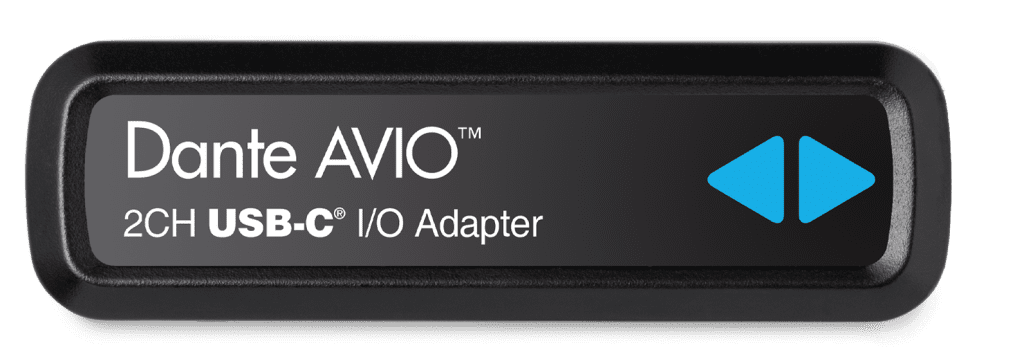Last update: 11-01-2024: flow handling added.
Introduction
Audinate is the inventor of the Dante system and still owns the heart and soul of Dante. As we all know Audinate builds middle products. Hardware and software components that other manufactures can implement in their products so that these products will be Dante compliant. An interesting business case when your idea really hits the market. Like Dante is doing now.So, it must have been quite an (unpleasant) surprise for the manufactures that work with Audinate finding out that Audinate started an end-product line of their own. The product line of Audinate is called AVIO™ adapters. They have many types from Bluetooth, AES, 2channel analog input and 2 channel analog output. Today I look at the USB-C version of the AVIO adapter
What is a Dante AVIO USB-C adapter?
This adapter connects your computer or laptop to a Dante network. It will give you two channels of inputs and outputs to your connected computer on the Dante network.
The AVIO USB-C is audio USB Class Compliant. This means that it should work without installing any driver on your computer. But it also means it will work with your iPad, iPhone, and Android phones. It even works with my 6-year-old Samsung Note8. Giving them direct access to your Dante infrastructure for playback and recording is great.
The AVIO adapter product line is priced in a range between 200 and 300 euro including 21% VAT.
Configuration of the Dante AVIO™ USB-C adapter
The AVIO adapter product line works in combination with PoE from the network switch. This USB-C version can deliver power to your device for charging as well.
The first thing we must do is connect it to the network. Then it will appear in the Dante Controller application. Go to the Device View and check its state. Oeps, the AVIO USB-C only works at a sample rate of 48kHz. It can’t be changed. Also, the encoding (bit depth) is fixed on 24 bits. This means that the receiver or transmitter on the Dante network that you want to connect with, must also run on 48kHz. Both limitations do not apply to the full AVIO product line. The AVIO AES version for instance supports sample rates from 44.1kHz to 96kHz and bit depth from 16 to 32 bits. So why this limitation?
The AVIO USB-C adapter support 2 transmitting (and receiving) flows of 2 channels. In practice this means you can send at the same time the output from your computer to two different hardware devices (receivers) on the Dante network. Sending PC audio multiple times to the same device is no issue, this doubling is done on the receiver side and not affecting the network at all. So if you (for testing) want your Apple Music played on all 16 input channels of your Dante connected mixer you can do so. If you want to send your Apple Music to different mixers you are limited by two mixers at the same time.
The Adapter is AES67 compliant and has a latency setting between 1 and 5ms.
It Only works
At
48kHz
sample rate
When the adapter configured for the Dante network you can connect the USB-C side. It is possible with your computer, iPad, or phone. So, setup a Dante routing and let’s play some music Garro! Well yes and no.
The 48kHz sample rate of the AVIO adapter is also forwarded to the USB connected device. There is no re-sampling between input and output within as described my earlier MuxLab (link) review.
Using the Apple OS then this won’t be a problem. When selecting the AVIO as your sound device the sample rate is immediately corrected. Also, in your DAW this hard demand from the AVIO adapter is followed. Beware, it could result in a DAW session mismatch if you were working on a different sampling rate before switching to this AVIO adapter.
The AVIO USB-C in use
The DANE AVIO USB-C adapter turns out to be a reliable tool that is plug and play. This means if your Dante network is running on 48 kHz. The moment that I decided to configure my Dante studio network to 96kHz, the fun ended. From this point on I always must change the sample rate on the receiver or transmitter device to 48kHz first.
Heaving your iPad on the Dante network as a reference audio player in your studio during mixing and mastering is great. Routing it to any converter makes an A/B comparison a breeze.
For a future version of this product, I have two wishes. Make the sample rate support between 44.1 and 96kHz and make the USB-C sample rate independent from the Dante sample rate. This sample rate conversion should be of a high quality, of course.
Let’s hope Audinate has an ear for the users.
Leave a comment and become member of our Facebook Group All4Dante
About All4Dante
All4Dante is an independent platform for Dante equipment and networks. We perform tests and reviews of equipment in our own Dante lab and share the results on our platform. We see a future for Dante in the recording and pro-studio environment as well as in the music instrument segment. By addressing audience related topics we want to support the migration to a more AoIP world.



